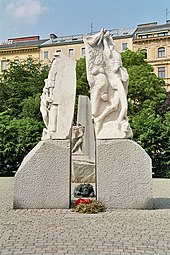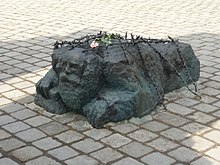Memorial against war and fascism
The memorial against war and fascism is the work of the Austrian sculptor Alfred Hrdlicka . It has stood on Vienna's Albertinaplatz since 1988 - named after Helmut Zilk in 2009 - across from the Archduke Albrecht Palace and the back of the Vienna State Opera . As a walk-in memorial , it is intended to serve as a reminder of the darkest epoch in Austrian history. It is dedicated to all victims of war and fascism .
history
At this point stood the Philipphof , a representative large residential building from the Wilhelminian era , which was destroyed by a bomb attack on March 12, 1945. Hundreds of people who had sought refuge in the cellars were killed. Some of the buried people could not be excavated; only 180 bodies were recovered. The exact number of victims could not be determined. The ruin was leveled in 1947 and the state owned property was no longer built on.
Here, in the Austrian year of reflection, in 1988, the City of Vienna erected the “Memorial against War and Fascism” on the initiative of Mayor Helmut Zilk . Design and execution were in the hands of the Austrian sculptor Alfred Hrdlicka. It was unveiled on November 24, 1988. It was the first monumental monument in public space that dealt with the Austrian past during the Nazi era and marked a turning point in the debate about Austria's "victim role" after the Waldheim affair (started in 1986).
The memorial
At the front of the square is the gate of violence . It is made of granite , as it was dragged by thousands of prisoners down the death stairs in the quarry of the Mauthausen concentration camp . The sculpture on the left is intended to commemorate the victims of the mass murder committed there and in other camps and prisons by the National Socialists , as well as the victims of resistance and persecution for reasons of national, religious and ethnic affiliation, mental and physical disabilities and sexual orientation. The group of figures on the right column is dedicated to the memory of all victims of the war. The faceless body of a woman giving birth is supposed to symbolize Austria's rebirth after the horrors of war.
The first victims of the National Socialist rulers, along with their political opponents, were the Jews . After Austria's "annexation" to the German Reich on March 12, 1938, Jews were forced to take part in friction games to clear the streets of pro-Austrian and anti-Nazi slogans. The bronze sculpture of a kneeling, street-washing Jew is a reminder of the degradation and humiliation that preceded the merciless persecution and murder of Jewish citizens immediately after the Anschluss.
Orpheus enters Hades , a male figure rising in a marble block, is a memorial for the bomb victims and for the sacrificial death of those who resisted National Socialism at the risk of their lives.
On April 27, 1945, when fighting was still going on in western Austria, the representatives of the new or re-established political parties proclaimed the re-establishment of the Republic of Austria through the Austrian Declaration of Independence . Excerpts from the declaration and the names of the men who signed it are immortalized on the Stone of the Republic . It is made of Mauthausen granite from the Perger drum mountain quarry, weighs 57 tons, is 8.4 meters high and is therefore the largest monolith that has ever been delivered from the Mühlviertel quarries.
gallery
"Portrait Bonhoeffer " (1977)
" Marsyas I" (1955/57 - 1962)
" Incarnation " (1994 - 1996)
acceptance
The erection of the memorial was accompanied by criticism at the time. On the one hand, some did not want a reminder of the role Austrians played during National Socialism; others found the central location near the State Opera and the Albertina offensive. On the other hand, the term “all victims of the war” has been criticized. The sculpture on the right shows a fallen Wehrmacht soldier with a steel helmet lying on the ground. Representatives of the Israelite religious communities like Simon Wiesenthal then campaigned for a separate memorial for the Jewish victims, which was erected in 2000 on Judenplatz .
The sculpture of the Jew for the rub was often not recognized as such. Some visitors sat on their backs to rest. The gold artist and sculptor Johannes Angerbauer-Goldhoff painted the sculpture with gold paint on May 25, 1990 in an announced art campaign ZAHN-GOLD-ZEIT-GOLD. The art operation was constantly observed by two state police officers and a detective. As a result, the artist was arrested while the sculpture was being transported away. Mayor Helmut Zilk , (the corresponding part of Albertinaplatz was named after him in 2009), as the owner's representative of the City of Vienna, initially reacted with the argument of property damage. An announced lawsuit against the artist was officially closed on January 21, 1991. In response, Alfred Hrdlicka put a barbed wire made of iron on the back of the statue to prevent further possession by people. The upward spines, by their sheen, show that the plastic is still being owned .
The memorial has found general acceptance over the years and is now a much-visited place.
Ruth Beckermann added a temporary installation to the memorial in March 2015, which shows in private film one of the “friction games” that Jewish Viennese were forced to do by the Viennese National Socialists in the spring of 1938.
literature
- Ulrike Jenni (Ed.): Alfred Hrdlicka. Memorial against war and fascism . Volume 1: Illustrations and text contributions. Volume 2: Documentation (The memorial in the mirror of the press) Theodor Scheufele (Ed.), Akademische Druck- u. Publishing house, Vienna 1992. ISBN 3-201015733
- Holger Thünemann: Holocaust Reception and History Culture . Central Holocaust Monuments in Controversy. A German-Austrian comparison . Schulz-Kirchner Verlag, Idstein 2005. ISBN 382480381X
Web links
- AEIOU | Albertinaplatz - memorial against war and fascism
- Nachkriegsjustiz.at | Memorial against war and fascism
Individual evidence
- ^ Josef Stummer: Granite - building block from Pulgarn to Gloxwald. Manuscript of a lecture given on March 17, 2010 for the Steinbrecherhaus Association in Perg, p. 5.
- ^ Johannes Angerbauer-Goldhoff : Gold attack campaign "ZAHN-GOLD-ZEIT-GOLD" socialgold.com
- ^ A "hate" at the "Reibpartie" report on the website of the Viennese daily Kurier from March 11, 2015
- ↑ Installation shows humiliation in “Reibpartie” , report on the ORF website, March 12, 2015
Coordinates: 48 ° 12 ′ 16.8 ″ N , 16 ° 22 ′ 6.8 ″ E










